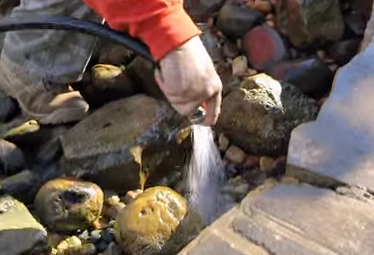Precious Cargo

Of all the tasks involved in giving a good-size pond a thorough spring cleaning, taking care of the fish is the biggest concern and, frankly, the riskiest part of the operation.
It’s not simply a matter of chasing them around the pond and cramming them into a net before unceremoniously dumping them in a garbage can: If the job is approached with that cruel and misguided spirit, it’s fully possible that the fish and other aquatic wildlife will show their appreciation by dying in droves.
As the video linked below demonstrates, we at The Pond Digger Waterscape Design & Construction (Yucaipa, Calif.) believe in treating the displaced fish with care and concern, even when they’re frisky and do all they can to hide from us in the safe places we’ve established for them in the pond. The key here is lowering the water level to limit where they can go. This is also helpful in that some of the removed water can be used to fill the container that will serve as a safe haven for the fish for the duration of the cleaning process.
And let me state something more strongly here than I do in the video: Although I offer it up as an option for homeowners who might not be patient enough to use a garden hose and their hands to wash the rocks and pebbles, using a pressure washer is not something I would recommend – particularly for a pond small enough that, even using a single hose, the work can be done in a day.
Here’s why: The slimy biofilm that forms on rock surfaces is too important a component of the ecosystem – especially in a small pond – to be sacrificed in the name of speedier sludge clearing. Steer away from the easy option and remember: Patience is a virtue!
To watch us work with the fish and start the sluicing process, click here.
Eric Triplett is founder and chief executive officer at The Pond Digger Waterscape Design & Construction in Yucaipa, Calif. He may be reached at eric@theponddigger.com.










